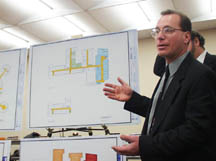After months of closed meetings and private dealings with the Town Council, the Board of Education finally unveiled at its Jan. 27 meeting plans to expand the two elementary schools, although the $5.9 million price tag may not reflect the real cost to the taxpayers. Board members, who have been reluctant to reveal the details behind the expansion plans even though they have had information about the cost and scope of the project since November, finally edged closer to revealing aspects of the plan, which will provide more classroom space in Clarendon and Huber Street schools. While school officials claim the new proposed bond for expansion is equal to about half of a proposed $10.4 million bond that the voters rejected in 1995, the board is playing down several important additional costs that could bring the final bill up to $8.4 million. The bond actually proposed by the Board of Education is $7.3 million and includes $1.5 million for various upgrades to passageways connecting the pod-style buildings of Clarendon School (see sidebar), repairs board members claim will have to be made whether or not expansion moves ahead. Yet for over a month, anxious board members have been in discussions with members of the Town Council to forge an agreement that would have the town purchase two plots of land near Huber Street School. Since board plans would make use of the existing school parking lot, the Town Council is under the gun to supply additional space for teachers and administrators or face having those vehicles parking on the residential streets around the school. Under the proposed agreement, the town would pay $900,000 for the property and the Board of Education would pay to have the buildings cleared for the construction of a new parking lot. The move has raised concerns from Councilman John Bueckner, who claims the town would not only have to pay the debt incurred from the purchase, but would also lose tax credits with the Hackensack Meadowlands Development Commission to the tune of $30,000 a year. The town of Secaucus currently pays into a tax sharing pool overseen by the HMDC. This pool compensates communities for inequities in development in the wetlands. Secaucus is not compensated because it has been allowed to develop more freely than certain other communities, and thus, it gets revenue from this development in additional taxes. But it can reduce its payments to the pool based on a complicated formula including the amount the Board of Education spends on its schools. The cost of educating students figures into this formula, and the higher the per-pupil cost, the less the town has to pay. “The town purchase of the land would reduce the [Board of Education’s] per-pupil cost,” Bueckner said. “While I am absolutely in favor of expanding, I’m not sure that the town should purchase the land if it means we lose those credits with the HMDC.” School officials claim it is imperative that the bond pass this time because the population of the schools are rising, forcing the board to make use of space not considered educationally sound. Some Pre-K classes are being held in the town’s Recreation Center. By playing down the actual combined cost of the proposed bond, some board members admitted they are lulling voters into approving the project. “If the voters reject this project I don’t know what we’ll do for space,” said one board member who wished to remain unnamed. Several board members also are facing the uncomfortable prospect of having to run for re-election with the bond in April, fearing they might lose their seats if voters vote against the bond. In 1995, the board ran a separate election to avoid this prospect. Voters that year not only voted down the bond, but later rejected the school budget, too, in what board members felt was a reaction to an apparently excessive bond request. “They were sending us a message,” another board member said. Not the same board Paul Amico, one of the three board members of the Buildings and Grounds Committee, who helped put the expansion plans together, claimed the 2000 bond lacks any of the frills the 1995 version had. “This is a lean bond issue,” Amico said. “Besides that, many of the items the board proposed in 1995 we have done through other funding.” The 1995 bond called for windows at Clarendon School; new lighting systems throughout the schools, roof repairs and air conditioning, and new lockers and new floors at the high school, all of which have been done through alternative funding. Amico and other board members have routinely stressed the change in the board since the 1995 bond was proposed, claiming that the people who put this bond together were not on the board in 1995. Only three of the nine board members from 1995 remain. Board President Michael Pesci said the expansion plans are now being sent to the state for their approval, and if the projected educational use fits with the state’s requirements, Secaucus should know by February whether or not the project can be presented to the voters at the regular board election on April 18.
Our Digital Archive from 2000 – 2016
